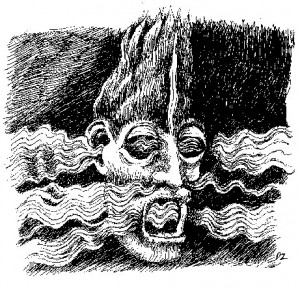Roger Skoff writes about audio's bottom line - bass and Hi-Fi.
When I was twelve years old, I had never heard bass. Really. Oh, I thought I had, but when you actually think about it, my guess is that not only will you understand and agree with what I just said; you may even discover that, at that or some even later age, you hadn't heard it either.
Instead of being surprised, stop for a moment and think: Where, at that tender young age, could I (or you) ever have heard it: In a live performance? At twelve years old, how could I ever have gotten there? How, if like most non-concert venues for live music, they served booze (or even just beer) could I have gotten in? Who would have paid for my ticket? Might I, perhaps, have heard it on the pipe organ at church? For one thing, because pipe organs are expensive, the overwhelming majority of churches didn't, then or now, have a pipe organ, and settled, instead, for a small reed or "portative" organ, which—both because of size and cost—didn't have anything at all in terms of "real" bass. For another, my family didn't go to church, and it wasn't until many years later—to attend a friend's wedding—that I set foot in a church for the first time.
What about at a concert? Might I have heard bass there? No. Kids don't go to concerts unless a parent (or some other adult) takes them. My parents didn't take me and I knew no one else who would. What about a marching band at a parade or sporting event? Yup, those do have bass drums—sometimes more than one or even more than a few of them. And yes, I did go, but, you know what? In an open air environment, at a distance of many yards, bass can't really be heard: It's there as an element of "power" or "solidity" and may be felt, but it's not really audible in the way bass is on a modern-day recording.
What about at a movie? In 1954 (yes, it really was more than sixty years ago) movie theaters didn't have anything at all like the sound quality they do today. With the old horn speakers that most of them used (remember that, for a horn to go low, it has to be big) 50Hz was the absolute lower limit, and many couldn't even do that. It wasn't until television came along and started to lure people away from the movies, that movie producers and theater owners started to pay attention to sound quality, and then stereophonic sound was added. Even so, it wasn't until the movie Earthquake that the ability to make deep bass—the kind that we expect from even a good home system today—became an important consideration.
If not the movies, back when I was twelve, could I (or you) have heard bass on the radio or (if your family was lucky or rich enough to have one) your television set? Not likely. Most radios were table-top units with, at best, four or five inch speakers, and although there were also BIG free-standing radios or radio/phonograph combinations, and some of them did have big (up to 12 inch) "full range" speakers, all invariably had open back enclosures (usually to allow venting the heat coming off their tube electronics) which allowed the sound (the pressure wave) coming off the front of the speaker to be canceled by the wave from the back, and prevented any kind of real bass response, even with the "bass" tone control (if there was one) turned all the way up. Television sets were exactly the same, with, regardless of their speaker size, open back boxes that canceled even what bass the drivers were capable of, and made the hearing of anything like music's actual bass content by a young kid (or, of course, anybody else) impossible.
With a record player, too—other than, of course, the HiFi units of the day, which were few and far between—there was no bass to hear; both because of speaker size and open back (or otherwise unsealed) cabinetry and because the "crystal" phono cartridges and limited-use "needles" of the day simply would not reproduce lower bass frequencies.
In fact, about the most impressive bass one could hear at the time was from one of the (often "Seeburg" brand) jukeboxes. The bass was loud, but that was about all, never extending much below 60Hz, at best, and, later, when subjective audio magazines (ones that actually told what things sound like) came along, one of the worst things a reviewer might say about a HiFi speaker system was that it had "one-note" or "jukebox" bass.
As many of you already know from earlier articles, the very first time that I actually heard bass was when my father and I accompanied my father's friend Mitch Rose to Emmons Audio in Studio City, California, to "help" him pick out a HiFi "set." Dick Emmons, the proprietor did his demonstration in mono (which was all there was at the time) on a McIntosh amplifier and a Bozak B-310 speaker (which, even at that time, was capable of solid bass down to 24Hz—nearly a full octave better than most of even the very best other speakers then available) And, just to make sure that Mitch and we innocent by-standers were properly blown away, his demo included George Wright playing the "Mighty Wurlitzer Pipe Organ" (with pedal pipes all the way down to 32Hz, and the organist well and truly stomping on them) at truly head-crushing, gut- and wall-shaking, soul-stirring volume!
Well, it worked! My father's friend bought his system, and I—overwhelmed by a phenomenon the likes of which I had never before even conceived of—became, still to this day, a life-long HiFi Crazy.
The effect that real, clean, "tight," "punchy" bass—a pipe organ that shakes the walls or a kick drum that actually kicks—has on people who have never heard it also continues "still to this day". You've probably even experienced it yourself: When you've demonstrated your own system to an audiophile "newbie" or to someone who's never been exposed to our hobby at all, and you play some great "show-off" piece to "blow 'em away," curl his toes, and bring him into the fold, isn't it far more likely that the first thing he'll notice and comment on is the bass, and not the imaging, soundstaging, harmonic richness, dynamics, attack and decay, or any of the other standard audiophile criteria?
Bass, whether it directly affects some ancient part of our brain or for some other reason, is powerful stuff. As rhythm or drone, it's the base from which all of our music builds, and it's simply great fun.
Want proof? Next time you play the 1812 Overture on your two-channel system or you play some great war, science fiction, or disaster movie on your home theater, turn off the sub-woofer and see what happens.
Even when the picture is still there, the fun goes away.






































